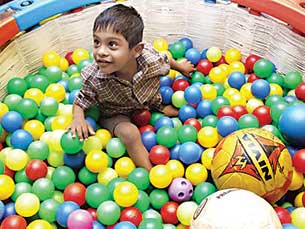Gita Nambiar
“We don’t have any children with learning difficulties”, was the curt reply of the principal of a reputed school when we approached him to conduct a workshop for teachers on this topic. Our intention was to create awareness of the increasing prevalence of this problem among school children. In every class, in every school there is a small percentage of children, who are trailing behind the rest in reading, spelling, comprehension, and numeracy. Should they not be given an opportunity to better their skills and move ahead with the rest of their peers?
Early identification coupled with immediate intervention allows such children to overcome their inadequacies to a great extent and bridge the gap with normal children. The etiology of these difficulties continues to be a topic for research. The child may be dyslexic, having dyscalculia, dysgraphia, difficulties with paying attention, a slow learner or falling within the autism spectrum. It is essential for regular school teachers to be aware of these disorders and pick out children in their classes who might possibly fall into these categories without necessarily giving them a clinical label. The teacher can refer kids with difficulties to a professional who can provide help. If not identified in the early stages, these difficulties get compounded and the gap widens between these children and their peers.
 Some of the symptoms that pre-school and kindergarten teachers could look out for are articulation difficulties, difficulty in learning and remembering names of letters, inability to associate letters with sounds and inability to read common one-syllable words such as ‘mat’, ‘cat’, etc., and reading errors that show no connection to the sounds of letters, for e.g., ‘big’ is read as ‘goat’. In primary school children, difficulties include a failure to acquire fluency in speech, use of language that is not precise, not being able to find the exact word and trouble remembering dates, names, and numbers. These children may be slow in acquiring reading skills, will have trouble reading unfamiliar words, and have fear of reading aloud. Spellings will be poor and word problems in math will pose a challenge. Many of these difficulties will persist if not remedied, even as the child moves from one class to the next.
Some of the symptoms that pre-school and kindergarten teachers could look out for are articulation difficulties, difficulty in learning and remembering names of letters, inability to associate letters with sounds and inability to read common one-syllable words such as ‘mat’, ‘cat’, etc., and reading errors that show no connection to the sounds of letters, for e.g., ‘big’ is read as ‘goat’. In primary school children, difficulties include a failure to acquire fluency in speech, use of language that is not precise, not being able to find the exact word and trouble remembering dates, names, and numbers. These children may be slow in acquiring reading skills, will have trouble reading unfamiliar words, and have fear of reading aloud. Spellings will be poor and word problems in math will pose a challenge. Many of these difficulties will persist if not remedied, even as the child moves from one class to the next.
Once these children have been identified by the parent, teacher, psychologist, or paediatrician, it is essential to get a comprehensive assessment conducted, in order to identify their strengths and weaknesses. To begin intervention, a true profile of the child is required. The assessment can be conducted in the school or at remedial centres that specialize in assessments and intervention. The younger the child, the easier it is for him to overcome his learning deficits.
An assessment also reveals whether there is any necessity for other kinds of intervention such as speech therapy for children with difficulty in articulation, occupational therapy for those who are restless and inattentive, physiotherapy for children with gross – and fine-motor difficulties and behaviour therapy for disruptive and maladjusted children.
In a majority of these children, low self-esteem is very common. This may manifest in many ways ranging from complete withdrawal, to misconduct and even substance abuse, particularly for older children. It is of the utmost importance for school teachers to be sensitive to the feelings of these children and provide whatever assistance possible within the time and resources at their disposal. Avoiding rude and sarcastic language and offering words of encouragement will motivate them to put in their best efforts. Promoting extracurricular activities that they excel in, also helps boost their self-esteem.
Not only in developing countries, but also in developed ones, more and more children at the primary school level are being diagnosed with learning difficulties. In such a situation, teachers in mainstream schools should arm themselves with the capability to look out for and identify the symptoms of learning difficulties and provide intervention. This would be in the best interests of the children, as well as the school, and the community at large.
The author works as a Special Educator at PRAYATNA. She can be reached at gitanambiar2010@gmail.com.
